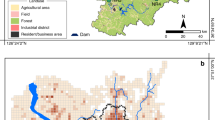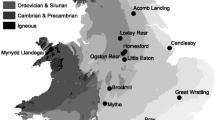Abstract
Lithium, generally, occurs in barely trace amounts in ground water with few major exceptions. One of these is the northern area of Chile where all potable water and many of the food stuffs contain high levels of lithium. Surface water can contain between 100 and 10,000 times more than most rivers in North America. Inevitably, food, both animal and vegetable, contains higher lithium levels than found elsewhere. In consequence, the local population has been exposed to high levels of lithium in their food and drinking water for as long as the region has been populated. The present report details lithium levels in a variety of food stuffs from several locations in Northern Chile and compares these with those found elsewhere. The implications for the local population have been discussed in our earlier paper.



Similar content being viewed by others
Notes
Historically, the ancient people from the coast would periodically trade shellfish and fish to those living in the Altiplano, something now rarely done.
Figueroa and Eschobar [8] give a detailed description of the habitat, growth cycle, and physical characteristics of each species
Based on analyses of lithium in 1 day dietary composites and mixed diet standards in Southern Ontario by Clarke and Gibson [28].
References
Figueroa LW, Razmillic B, Zumeata O, Barr R, Nina Aranda G, Barton S, Schull Young A, Kamiya, Y, Hoskins J, Ilgren E (2012) Environmental lithium exposure in the North of Chile—I. Natural water sources. Biol Trace Element Res 149:280–290
Schrauzer G (2002) Lithium: occurrence, dietary intakes, nutritional essentiality. J Am Col Nutr 21:1–9
Aral H, Vecchio-Sadus A (2008) Toxicity of lithium to humans and the environment—a literature review. Ecotoxicol Environ Saf 70:349–356
Moore J (1995) An assessment of lithium using the IEHR Evaluative Process for Assessing Human Developmental and Reproductive Toxicity of Agents. IEHR Expert Scientific Committee. Repro Tox 9:175–210
Broberg K, Concha G, Engström K, Lindvall M, Grandér M, Vahter M (2011) Lithium in drinking water and thyroid function. Environ Health Perspect 119:827–830. doi:10.1289/ehp.1002678
Wright C, Astudillo J, Melindez E, Alcayaga G (1961) Supplement to the 1st Quarterly Report of the Assessor in Soils. FAO – Chile. Appdx III. Notes on soils, natural vegetation, and land use in the department of Arica, Province of Tarapaca, Chile. 122 pp
Barton S, Williams C, Baria I, Murillo F (1990) Nutritional characteristics of the Aymara of northern Chile. In: In: Schull W, Rothhamer F (eds) The Aymara: strategies in human adaptation to a rigorous environment. Kluwer, Dordrecht, pp 63–70
Figueroa L, Eschobar H (1981) Caracteristicas botanicas y quimicas de tres pastos forrajeros nativos del parque National Lauca In: Quimica. Revista de la Univ del Norte Arica, No. 8, Sept. 1981, pp 80–132
Figueroa L (1981) Analisis foliar de tomate en un period completo de su ciclo vegetativo (Analysis of the lithium concentrations found in the leaves of the tomato plant through the vegetative cycle) ‘Quimica. Revista de la Univ del Norte Arica.’ No. 8, Sept. 1981
Mladinic P, Hrepic N, Quintana E (1987) Caracterization fisica y quimica de las aguas de los lagos Chungara y Cotocotani. Arch Biol Med Exp 20:89–94
Figueroa L, Arrigada R, Picarte R, Gallegos N (1981) Caracterization quimica de efloresciencias Salinas de dos ‘Bofedales’ de la provincial de Parinacota—Chile, (1981). ‘Quimica. Revista de la Univ del Norte Arica.’ No. 8, Sept. 1981
Mulhauser H, Hrepic N, Mladinic P, Montecino V, Cabrera S (1995) Water quality and limnological features of a high altitude Andean lake, Chungard, in northern Chile. Rev Chil Hist Nat 68:341–349
Marquez-Garcıa M, Vila I, Hinojosa L, Mendez M, Carvajal J, Sabando M (2009) Distribution and seasonal fluctuations in the aquatic biodiversity of the southern Altiplano. Limnologica 39:314–318
Schull W, Razmilic B, Figueroa L, Gonzalez M (1990) Trace metals. In: Schull W, Rothhamer F (eds) The Aymara: strategies in human adaptation to a rigorous environment, Chap. 3, Kluwer, Dordrecht, pp 33–44
Barr R, Koekebakker M, Brown EA, Falbo MC (1987) Putative role for lithium in human hematopoiesis. J Lab Clin Med 109:159–163
Kasuya J, Kaas G, Kitamoto T (2009) Effects of lithium chloride on the gene expression profiles in Drosophila heads. Neurosci Res 64:413–420
Voisine C, Varma H, Walker N, Bates EA, Stockwell BR et al (2007) Identification of potential therapeutic drugs for Huntington’s disease using Caenorhabditis elegans. PLoS One 2(6):e504. doi:10.1371/journal.pone.0000504
Bilen J, Bonini N (2005) Drosophila as a model for human neurodegenerative disease. Annu Rev Genet 39:153–171
Hayward P (2004) Lithium reverses tau pathology in Drosophila. Lancet Neurology 3:265. doi:10.1016/S1474-4422(04)00759-8
Ammar T, Yasin A, Abu-Baker S, Dababneh B, Tahboub A (2010) The occurrence of lithium in the environment of the Jordan Valley and its transfer into the food chain. Env Geochem Health 33:427–437. doi:10.1007/s10653-010-9334
Anke M, Angelow L, Arnhold W, Mullen R, Shafer U (2005) Lithium and rubidium in the food chain, in take by man, essentiality and toxicity. Satellite Symposium on Lithium. 12 October 2005. Athens, Greece
Haddadin M, Khattari S, Caretto D, Robinson R (2002) Potential intake of lithium by the inhabitants of different regions in Jordan. Pakistan J Nutr 1:39–40
Barr R, Clark W, Clarke R, Venturelli J, Norman G, Downing G (1993) Regulation of lithium and boron levels in normal human blood: environmental and genetic considerations. J Lab Clin Med 121:614–619
Concha G, Broberg K, Grander M, Cardozo A, Palm B, Vahter M (2010) High-level exposure to lithium, boron, caesium, and arsenic via drinking water in the Andes of Northern Argentina. Environ Sci Technol 44:6875–6880
Grandjean EM, Aubry JM (2009) Lithium: updated human knowledge using an evidence-based approach. Part I: clinical efficacy in bipolar disorder. CNS Drugs 23:225–240
Weiner ML (1991) Overview of Lithium Toxicology. In: Schrauzer GN, Klippel K (eds) Lithium in biology and medicine: new applications and developments. VCH, New York, pp 81–100
Weiner ML (1993) The human dose response to lithium—from trace to toxic levels. In: Birch NJ, Padgham C, Hughes MS (eds) Lithium in Medicine and Biology. Marius Press, Carnforth, pp 15–25
Clarke WB, Gibson RS (1988) Lithium, boron, and nitrogen in 1-day diet composites and a mixed-diet standard. J Food Compos Anal 1:209–220
Author information
Authors and Affiliations
Corresponding author
Rights and permissions
About this article
Cite this article
Figueroa, L.T., Razmillic, B., Zumeata, O. et al. Environmental Lithium Exposure in the North of Chile—II. Natural Food Sources. Biol Trace Elem Res 151, 122–131 (2013). https://doi.org/10.1007/s12011-012-9543-1
Received:
Accepted:
Published:
Issue Date:
DOI: https://doi.org/10.1007/s12011-012-9543-1




